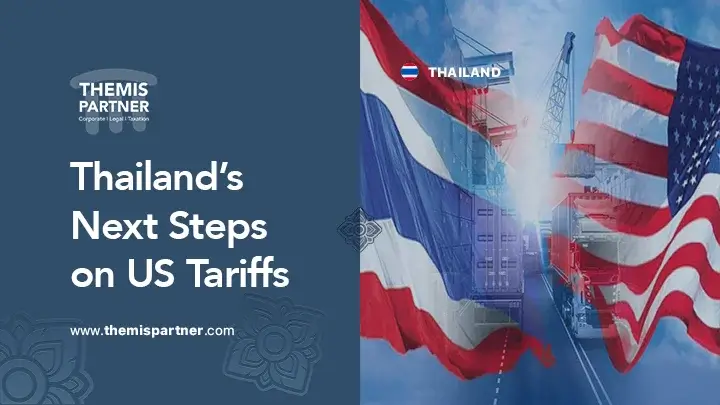Thailand maps next steps on US tariffs as new trade measures could reshape your export strategy as early as Q3 2025. With US tariffs on Thai goods recently reduced from 36% to 19%, business owners and professionals face crucial choices regarding compliance, market diversification, and government support.
Are you prepared to adapt your operations if your core products are suddenly facing higher duties or stricter documentation checks? A US$15 billion government stimulus and new legal frameworks are now in place to help Thai companies safeguard revenue, maintain market access, and pivot quickly in response to shifting regulations.

This guide offers practical action points: how to document compliance, seize opportunities through ASEAN and EU expansion, and use digital traceability as your risk shield.
Key Takeaways
- Thailand’s rapid multi-agency strategy deployed negotiators, launched a US$15 billion stimulus package, and accelerated market diversification to stabilize the economy following US tariff changes.
- **Targeted trade concessions and legal upgrades **including zero tariffs on select US imports, compliance with US Customs, and digital traceability, empower Thai exporters to maintain US market access and reduce penalty risks.
- Decisive negotiations halved US tariffs on Thai goods from 36% to 19% in 2025, with direct high-level talks and precise trade data leading to faster, more favorable outcomes.
- Sector impacts are uneven: Autos and textiles saw exports fall by up to 12% and 8%, while electronics and digital consumer brands offset losses by pivoting to ASEAN and the EU.
- SMEs relying on US sales face the greatest risk unless they diversify markets, upgrade traceability systems, and utilize government grants for support and retraining.
- Exporters increased ASEAN trade by 14% and grew revenues over 11% through non-US deals, using “Thailand+1” strategies, cross-border e-commerce, and new joint ventures to bypass tariff exposure.
- Mastering compliance now requires seven steps: from accurate HS code validation to internal audits and digital record-keeping, as errors trigger costly shipment delays.
- Government-backed programs offer grants, counseling, and tariff monitoring, helping businesses build resilience and seize new opportunities amid shifting global trade flows.
Table of Contents
Thailand’s Next Steps on US Tariffs
US-Thailand Tariff Negotiations
Sector Impacts: Winners and Risks
Export Diversification to Reduce Tariff Risks
Legal & Compliance Steps for 2025 US Tariffs
FAQ: Thailand’s US Tariff Strategy 2025
Conclusion
Thailand’s Next Steps on US Tariffs
Immediate Government Responses to Protect the Economy
Thailand responded to the 2025 US tariffs announcement by launching a coordinated, multi-agency strategy within days.
A national task force, led by the Prime Minister and involving trade officials, quickly initiated direct talks with US counterparts to mitigate impacts and reassess Thailand’s tariff policy.
Key measures included:
- Deploying negotiators and policy teams for high-level trade discussions
- Rolling out a US$15 billion stimulus package focused on infrastructure upgrades, SME support, and incentives for the tourism sector
- Accelerating market diversification efforts across ASEAN, the EU, and other regions
Business leaders can reference the NESDC and IMF for real-time economic projections and stimulus details.
Trade Concessions and Legal Compliance Shaping Outcomes
Thailand’s export response included offering zero tariffs on select US goods like beef and alcohol, to narrow the trade surplus and support US-Thailand trade 2025 negotiations.
The government also prioritized:
- Strengthening product traceability and inspection systems to meet US regulatory compliance
- Introducing legal frameworks designed to protect businesses from potential penalization or retroactive duties
- Ensuring Thai exporters meet updated US Customs requirements while adopting new digital tracking methodologies
For official reports and further legal insights, see current USTR releases and Thai Ministry of Commerce updates.
A multi-pronged approach empowers stakeholders to navigate evolving tariff regimes confidently.
Thailand’s multi-agency strategy, combined with targeted trade concessions and regulatory upgrades, equips exporters and investors to minimize US tariff risks while supporting long-term trade resilience.
US-Thailand Tariff Negotiations
Key Changes in the Negotiation Process
Thailand’s decisive response helped reduce US tariffs on Thai goods from 36% to 19% in 2025. This breakthrough resulted from deploying multi-level negotiation teams, combining economic data with active executive and ministerial leadership.
Key negotiation tactics included:
- Presenting targeted trade concessions, such as zero tariffs for select US imports (beef, liquor)
- Sharing precise export and impact data with US Trade Representative officials
- Engaging in direct, high-level talks emphasizing compromise and trade balance
Unlike previous disputes, the 2025 negotiations involved synchronized engagement by the Prime Minister, trade ministers, and technical policy teams. These efforts underscored Thailand’s commitment to pragmatic, legally sound solutions (USTR, Reuters).
Latest Discussion Points and Future Expectations
Current US-Thailand tariff discussions focus on key unresolved issues:
- Expanded US agricultural product access
- Industrial quotas and reciprocal tariff formulations
- Future compliance standards to prevent transshipment
Anticipated milestones include:
- Interim review of tariff rates in Q4 2025
- Announcements on new reciprocal access agreements
Recent statements from both governments suggest ongoing openness to additional tariff reductions. Expert consensus: “A flexible, data-driven approach keeps Thailand’s trade options strong amid tariff uncertainty.”
Thailand’s negotiation process demonstrates how data, compromise, and leadership accelerate progress on complex trade issues, reinforcing the value of inclusive, cross-agency coordination for sustainable outcomes.
Sector Impacts: Winners and Risks
Effects of US Tariffs on Key Export Sectors
US tariffs in 2025 have reshaped Thailand’s manufacturing, electronics, agriculture, and consumer goods exports. The impact is visible in both short-term disruptions and long-term strategic shifts.
- Manufacturing (autos, textiles): Thai exports in autos fell by 12% in Q2 2025, with textiles down 8%. Firms face heightened supply chain scrutiny and pausing of some Western orders.
- Electronics: Export volume remained stable, driven by supply chain redesign and increased demand from ASEAN partners.
- Agriculture: Higher US tariffs on processed foods saw a 15% drop in US-bound shipments, while fruit and seafood shifted to Japan and the EU.
- Consumer goods: Brands pivoted digital sales to the Middle East, offsetting US market losses.
Key sources: Thai Federation of Industries, World Bank reports, and recent sector trade association analyses.
Tariffs have pressed leaders to rethink market priorities and value chains.
Stakeholders Facing Opportunities and Risks
Stakeholder experiences in 2025 vary sharply as US-Thailand trade dynamics change.
- At-risk: SMEs relying on the US for over 60% of revenue, new manufacturers without compliance infrastructure, and regions with high export labor density.
- Opportunity: Digital-first brands, firms shifting to ASEAN and EU customers, and those investing in transparent supply chains.
- Dislocated labor forces: 45,000+ workers have shifted sectors, with retraining supported by government stimulus.
- Risk management: Exporters are advised to diversify markets, strengthen product traceability, and review tariff classifications monthly.
- Government-private sector programs: Offer grants, export counseling, workforce retraining, and real-time tariff monitoring.
Market shifts triggered by US tariffs are reshaping Thai industry. Businesses that respond quickly can safeguard jobs, capture new markets, and strengthen compliance frameworks for future stability.
Export Diversification to Reduce Tariff Risks
Diversification Tactics of Thai Exporters
Thai exporters have moved swiftly to minimize risks linked to US tariffs by expanding into alternative markets and reshaping international strategies.
Key approaches include:
- Strengthening trade within ASEAN (up 14% in 2025), targeting Vietnam, Indonesia, and Malaysia
- Increasing exports to the EU, Japan, and the Middle East, where growth has outpaced US-bound shipments
- Redesigning supply chains to move assembly and sourcing beyond US-destined lines
- Supporting firms like Thai Union and Mitr Phol, which grew revenue by over 11% through new deals outside the US
Visit ASEAN Secretariat and Thai Chamber of Commerce for additional trade data and expert guidance.
Innovation and New Market Development Driving Resilience
Innovation is reshaping Thailand’s export trajectory through:
- Continual product adaptation for regional tastes and certifications
- Embracing digital export channels and cross-border e-commerce, which fueled a 22% spike in B2B deals in 2025
- Joint ventures, FDI pivots, and adoption of the “Thailand+1” model, combining investment in neighbouring countries for supply chain stability
Effective diversification provides a safeguard against tariff risk while empowering Thai businesses to thrive across dynamic global markets.
Legal & Compliance Steps for 2025 US Tariffs
Essential Legal and Regulatory Requirements
Thai exporters must take decisive legal steps to access the US market in 2025 with full compliance and minimized risk.
The seven critical steps are:
- Accurate export documentation
- HS code validation
- Certificates of Thai origin
- Adherence to updated US Customs guidelines
- Transparent record-keeping systems
- Internal audits for trade compliance
- Documentation against transshipment allegations
The cost of non-compliance, including fines or shipment delays, remains high as US Customs and Border Protection and the Thai Customs Department increase scrutiny.
Enhanced traceability systems are required, especially for electronics and textiles.
A single error in documentation can quickly block exports, making a compliance-first culture essential for every Thai business.
See latest Thai Customs Procedures: Complete Guide for 2025
Building Ongoing Compliance for the US Market
Practical compliance starts by building dedicated teams and leveraging digital tools.
Key steps include:
- Appointing in-house trade compliance officers
- Retaining qualified legal consultants
- Using digital traceability systems
- Regular staff training on US tariff policies
- Applying proactive checklists before shipping
Small and medium-sized enterprises can access government-backed digital compliance guides and international help through:
These steps make legal compliance a business advantage, not just a checkbox.
FAQ: Thailand’s US Tariff Strategy 2025
Thailand’s map of next steps on US tariffs directly impacts prices, export paths, and support for affected businesses. Here are the most frequent questions answered for business owners and stakeholders.
How will US-Thailand talks affect Thai consumer prices in 2025?
- Prices on US-imported goods, such as electronics and specialized machinery, are forecast to rise by 3% to 5% as of Q3 2025.
- Key sectors may see short-term cost increases, but government stimulus and SME support programs are helping offset consumer price spikes.
Even with a 19% tariff, Thai officials expect household goods to remain stable for most families.
What steps should new exporters take to reduce legal and financial risks?
- Validate all export documentation, including product classification codes.
- Use traceability technology to prove Thai product origin and avoid transshipment allegations.
- Consult with trade experts or legal advisors on changing US and Thai customs requirements.
Clear documentation and real-time traceability are now essential for exporters entering the US market.
Which alternative export destinations are growing for Thai products in 2025?
- ASEAN markets, the European Union, and Japan offer robust growth potential after the US tariffs.
- Thailand’s “Thailand+1” strategy means many firms are also investing in regional partners to widen market resilience.
For ASEAN market data, visit the ASEAN Secretariat or Thai Chamber of Commerce.
Are there government grants or support programs for tariff-affected businesses?
- Thailand’s government stimulus (US$15 billion) funds SMEs, supply chain upgrades, and workforce retraining.
- Exporters can access financing and technical assistance through the Board of Investment and Ministry of Commerce.
These insights highlight that while tariff changes increase short-term complexity, the right trade strategies and government support can secure long-term growth and resilience for Thai exporters.
Conclusion
Navigating the evolving US tariff landscape requires agility, compliance, and a proactive export strategy, empowering your business to adapt and thrive amid global change.
If you need tailored guidance on legal frameworks, negotiation strategy, or real-time compliance, contact us today. Themis Partner will help you minimize risk, seize new opportunities, and streamline your pathway to sustainable US trade.
